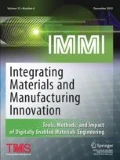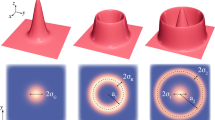Abstract
Post-heat treatment takes a key role for the enhancement of mechanical properties in selective laser melting (SLM) additive manufacturing (AM) of 6xxx series aluminum alloy. To understand the basic mechanism for changes of mechanical properties in the SLM process and the following post-heat treatment, the finite element model and the precipitate evolution (PE) model of SLM AM were established and combined. Results show that the hardness of the fabricated AM component can reach 91.47 HV at 170 °C for 18.8 h, which is 63.1% higher than the as-fabricated state. The comparison of hardness in as-fabricated AM component with experiments shows the validity of the proposed models. Further work on chemical composition shows that the selection of powder particle can greatly affect the hardness of the fabricated AM component. In the selection of 6xxx series aluminum alloy powder, higher Mg and Si contents in their solubility domains lead to higher generation of Mg2Si nano-size precipitates and then cause higher hardness of AM specimen. After the optimal post-heat treatment, the maximum hardness can exceed 100 HV.

















Similar content being viewed by others
References
Ngo TD, Kashani A, Imbalzano G et al (2018) Additive manufacturing (3D printing): a review of materials, methods, applications and challenges. Compos Part B Eng 143:172–196. https://doi.org/10.1016/j.compositesb.2018.02.012
DebRoy T, Wei H, Zuback JS et al (2018) Additive manufacturing of metallic components: process, structure and properties. Prog Mater Sci 92:112–224. https://doi.org/10.1016/j.pmatsci.2017.10.001
Herzog D, SeydaV WE, Emmelmann C (2016) Additive manufacturing of metals. Acta Mater 117:371–292
Gu DD, Meiners W, Wissenbach K, Poprawe R (2012) Laser additive manufacturing of metallic components: materials, processes and mechanisms. Int Mater Rev 57:133–164. https://doi.org/10.1179/1743280411y.0000000014
Shamsaei N, Yadollahi A, Bian LK, Thompson SM (2015) An overview of direct laser deposition for additive manufacturing. Part II: mechanical behavior, process parameter optimization and control. Addit Manuf 8:12–35. https://doi.org/10.1016/j.addma.2015.07.002
Riquelme A, Rodrigo P, Escalera-Rodriguez MD, Rams J (2019) Effect of the process parameters in the additive manufacturing of in situ Al/AlN samples. J Manuf Process 46:271–278. https://doi.org/10.1016/j.jmapro.2019.09.011
Fayazfar H, Salarian M, Rogalsky A et al (2018) A critical review of powder-based additive manufacturing of ferrous alloys: process parameters, microstructure and mechanical properties. Mater Des 144:98–128. https://doi.org/10.1016/j.matdes.2018.02.018
Moser D, Cullinan M, Murthy J (2019) Multi-scale computational modeling of residual stress in selective laser melting with uncertainty quantification. Addit Manuf 29:100770. https://doi.org/10.1016/j.addma.2019.06.021
Lindgren LE, Edberg J, Akerstrom P, Zhang Z (2019) Modeling of thermal stresses in low alloy steels. J Therm Stresses 42:725–743. https://doi.org/10.1080/01495739.2019.1587329
Lindgren LE, Lundback A, Fisk M et al (2016) Simulation of additive manufacturing using coupled constitutive and microstructure models. Addit Manuf 12:144–158. https://doi.org/10.1016/j.addma.2016.05.005
Maconachie T, Leary M, Lozanovski B et al (2019) SLM lattice structures: properties, performance, applications and challenges. Mater Des 183:108137. https://doi.org/10.1016/j.matdes.2019.108137
Zhao Z, Chen J, Tan H, Tang J, Lin X (2020) In situ tailoring microstructure in laser solid formed titanium alloy for superior fatigue crack growth resistance. Scr Mater 174:53–57. https://doi.org/10.1016/j.scriptamat.2019.08.028
Liu Y, Zhang J, Pang ZC (2018) Numerical and experimental investigation into the subsequent thermal cycling during selective laser melting of multi-layer 316L stainless steel. Opt Laser Technol 98:23–32. https://doi.org/10.1016/j.optlastec.2017.07.034
Loh LE, Chua CK, Yeong WY et al (2015) Numerical investigation and an effective modelling on the Selective Laser Melting (SLM) process with aluminium alloy 6061. Int J Heat Mass Transf 80:288–300. https://doi.org/10.1016/j.ijheatmasstransfer.2014.09.014
Yuan PP, Gu D (2015) Melt pool behaviour and its physical mechanism during selective laser melting of TiC/AlSi10Mg nanocomposites: simulation and experiments. J Phys D Appl Phys 48:035303. https://doi.org/10.1088/0022-3727/48/3/035303
Wang Z, Yan W, Liu W, Liu M (2019) Powder-scale multi-physics modeling of multi-layer multi-track selective laser melting with sharp interface capturing method. Comput Mech 63:649–661. https://doi.org/10.1007/s00466-018-1614-5
Ge P, Zhang Z, Tan Z et al (2019) An integrated modeling of process-structure-property relationship in laser additive manufacturing of duplex titanium alloy. Int J Therm Sci 140:329–343. https://doi.org/10.1016/j.ijthermalsci.2019.03.013
Johnson KL, Rodgers TM, Underwood OD et al (2018) Simulation and experimental comparison of the thermo-mechanical history and 3D microstructure evolution of 304L stainless steel tubes manufactured using LENS. Comput Mech 61:559–574. https://doi.org/10.1007/s00466-017-1516-y
Wang X, Chou K (2019) Microstructure simulations of Inconel 718 during selective laser melting using a phase field model. Int J Adv Manuf Technol 100:2147–2162. https://doi.org/10.1007/s00170-018-2814-z
Yao XX, Ge P, Li JY et al (2020) Controlling the solidification process parameters of direct energy deposition additive manufacturing considering laser and powder properties. Comput Mater Sci 182:109788. https://doi.org/10.1016/j.commatsci.2020.109788
Zinoviev A, Zinovieva O, Ploshikhin V et al (2016) Evolution of grain structure during laser additive manufacturing. Simulation by a cellular automata method. Mater Des 106:321–329. https://doi.org/10.1016/j.matdes.2016.05.125
Prashanth KG, Eckert J (2017) Formation of metastable cellular microstructures in selective laser melted alloys. J Alloys Compd 707:27–34. https://doi.org/10.1016/j.jallcom.2016.12.209
Zhao JY, Wang GX, Ye C, Dong YL (2017) A numerical model coupling diffusion and grain growth in nanocrystalline materials. Comput Mater Sci 136:243–252. https://doi.org/10.1016/j.commatsci.2017.05.010
Andani MT, Karamooz-Ravari MR, Mirzaeifar R, Ni J (2018) Micromechanics modeling of metallic alloys 3D printed by selective laser melting. Mater Des 137:204–213. https://doi.org/10.1016/j.matdes.2017.10.026
Yan WT, Lian YP, Yu C et al (2018) An integrated process–structure–property modeling framework for additive manufacturing. Comput Methods Appl Mech Eng 339:184–204. https://doi.org/10.1016/j.cma.2018.05.004
Anderson MJ, Benson J, Brooks J et al (2019) Predicting precipitation kinetics during the annealing of additive manufactured inconel 625 components. Integr Mater Manuf Innov 8:154–166. https://doi.org/10.1007/s40192-019-00134-7
Cai XY, Dong BL, Bai JY et al (2019) Effects of post-deposition heat treatment on microstructures of GTA-additive manufactured 2219-Al. Sci Technol Weld Join 24:474–483. https://doi.org/10.1080/13621718.2019.1580440
Jahns K, Bappert R, Bohlke P, Krupp U (2020) Additive manufacturing of CuCr1Zr by development of a gas atomization and laser powder bed fusion routine. Int J Adv Manuf Technol 107:2151–2161. https://doi.org/10.1007/s00170-020-04941-7
Myhr OR, Grong O (2000) Modelling of non-isothermal transformations in alloys containing a particle distribution. Acta Mater 48:1605–1615. https://doi.org/10.1016/s1359-6454(99)00435-8
Zhang Z, Wan ZY, Lindgren LE et al (2017) The simulation of precipitation evolutions and mechanical properties in friction stir welding with post-weld heat treatments. J Mater Eng Perform 26:5731–5740. https://doi.org/10.1007/s11665-017-3069-9
Simar A, Brechet Y, de Meester B et al (2007) Sequential modeling of local precipitation, strength and strain hardening in friction stir welds of an aluminum alloy 6005A–T6. Acta Mater 55:6133–6143. https://doi.org/10.1016/j.actamat.2007.07.012
Gallais C, Denquin A, Brechet Y, Lapasset G (2008) Precipitation microstructures in an AA6056 aluminium alloy after friction stir welding: characterisation and modelling. Mater Sci Eng A 496:77–89. https://doi.org/10.1016/j.msea.2008.06.033
Jonckheere C, de Meester B, Denquin A et al (2013) Torque, temperature and hardening precipitation evolution in dissimilar friction stir welds between 6061–T6 and 2014–T6 aluminum alloys. J Mater Process Technol 213:826–837. https://doi.org/10.1016/j.jmatprotec.2013.01.001
Zhang Z, Tan Z, Li JY et al (2020) Integrated modeling of process-microstructure-property relations in friction stir additive manufacturing. Acta Metall Sin Engl 33:75–87. https://doi.org/10.1007/s40195-019-00945-9
Zhang Z, Tan Z, Li JY et al (2019) Experimental and numerical studies of re-stirring and re-heating effects on mechanical properties in friction stir additive manufacturing. Int J Adv Manuf Technol 104:767–784. https://doi.org/10.1007/s00170-019-03917-6
Samaras SN (2016) Effect of initial microstructure on the performance of 6xxx al-alloy laser welds: a computational study. J Mater Eng Perform 25:1729–1740. https://doi.org/10.1007/s11665-016-2037-0
Liu SW, Zhu JJ, Zhu HH et al (2020) Effect of the track length and track number on the evolution of the melt pool characteristics of SLMed Al alloy: numerical and experimental study. Opt Laser Technol 339:184–204. https://doi.org/10.1016/j.optlastec.2019.105924
Zhang Z, Yao XX, Ge P (2020) Phase-field-model-based analysis of the effects of powder particle on porosities and densities in selective laser sintering additive manufacturing. Int J Mech Sci. https://doi.org/10.1016/j.ijmecsci.2019.105230
Li YL, Gu DD (2014) Parametric analysis of thermal behavior during selective laser melting additive manufacturing of aluminum alloy powder. Mater Des 63:856–867. https://doi.org/10.1016/j.matdes.2014.07.006
Myhr OR, Grong O, Andersen SJ (2001) Modelling of the age hardening behaviour of Al–Mg–Si alloys. Acta Mater 49:65–75. https://doi.org/10.1016/s1359-6454(00)00301-3
Myhr OR, Grong O, Fjaer HG, Marioara C (2004) Modelling of the microstructure and strength evolution in Al–Mg–Si alloys during multistage thermal processing. Acta Mater 52:4997–5008. https://doi.org/10.1016/j.actamat.2004.07.002
Simar A, Brechet Y, de Meester B et al (2012) Integrated modeling of friction stir welding of 6xxx series Al alloys: process, microstructure and properties. Prog Mater Sci 57:95–183. https://doi.org/10.1016/j.pmatsci.2011.05.003
Trapp J, Rubenchik AM, Guss G et al (2017) In situ absorptivity measurements of metallic powders during laser powder-bed fusion additive manufacturing. Appl Mater Today 9:341–349. https://doi.org/10.1016/j.apmt.2017.08.006
Uddin SZ, Murr LE, Terrazas CA et al (2018) Processing and characterization of crack-free aluminum 6061 using high-temperature heating in laser powder bed fusion additive manufacturing. Addit Manuf 22:405–415. https://doi.org/10.1016/j.addma.2018.05.047
Anderson MJ, Panwisawas C, Sovani Y et al (2018) Mean-field modelling of the intermetallic precipitate phases during heat treatment and additive manufacture of Inconel 718. Acta Mater 156:432–445. https://doi.org/10.1016/j.actamat.2018.07.002
Jagle EA, Sheng ZD, Wu L (2016) Precipitation reactions in age-hardenable alloys during laser additive manufacturing. JOM 68:943–949. https://doi.org/10.1007/s11837-015-1764-2
Khadyko M, Myhr OR, Hopperstad OS (2019) Work hardening and plastic anisotropy of naturally and artificially aged aluminium alloy AA6063. Mech Mater. https://doi.org/10.1016/j.mechmat.2019.103069
Acknowledgements
This study is funded by the National Natural Science Foundation of China (No. 11572074) and Liaoning Provincial Natural Science Foundation (2019-KF-05-07).
Author information
Authors and Affiliations
Corresponding author
Ethics declarations
Conflict of interest
The authors declare that they have no conflict of interest.
Additional information
Publisher's Note
Springer Nature remains neutral with regard to jurisdictional claims in published maps and institutional affiliations.
Rights and permissions
About this article
Cite this article
Li, J.Y., Yao, X.X., Wang, Y.F. et al. The Simulation of Post-Heat Treatment in Selective Laser Melting Additive Manufacturing. Integr Mater Manuf Innov 10, 413–428 (2021). https://doi.org/10.1007/s40192-021-00222-7
Received:
Accepted:
Published:
Issue Date:
DOI: https://doi.org/10.1007/s40192-021-00222-7




